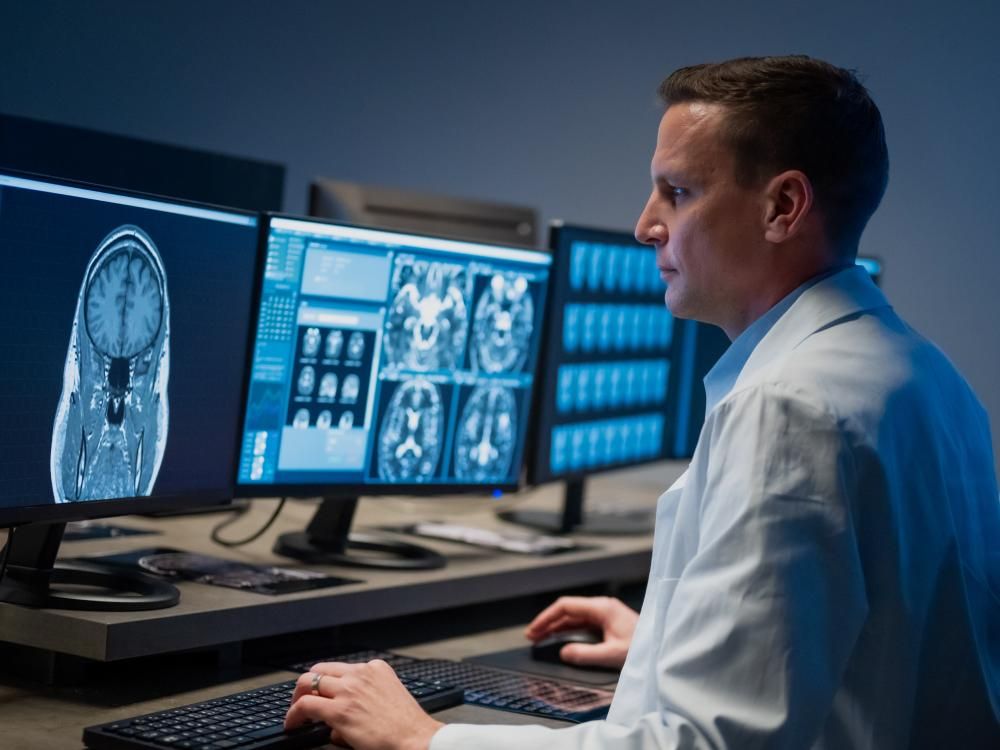
Hospital inventory management software: architecture, features, and platforms
November 21, 2025
- Home
- Healthcare software development solutions & services
- Hospital inventory management

by Sergey Ivanov,
Head of Healthcare Center of Excellence
With 25+ years in healthcare software development, Itransition assists its clients with implementing tailored hospital management software to automate routine activities and enhance patient care, while reducing operating expenses.
Table of contents
the global HIMS market size by 2027
ReportLinker
the global HIMS market CAGR, 2025 - 2031
Precision Business Insights
the annual healthcare system cost saving due to automation
CAQH Index
Main features of hospital inventory management software

Inventory tracking
- Real-time batch- and lot-level tracking of drugs, medical supplies, and equipment
- Generating unique barcodes with an item locator
- Automated stock reconciliation and discrepancy alerts
- Expiration dates data monitoring
Medical supply management
- Controlling the flow of supplies across departments, storage areas, and facilities
- Demand forecasting based on usage trends
- Managing medical supply data (ID, price, intended use description, etc.)
Medical equipment management
- Real-time equipment location and usage tracking
- Equipment lifecycle monitoring, from procurement to decommissioning
- Calibration tracking for diagnostic and clinical devices
Inventory automation
- Automated stock level updates based on item usage, dispensing, or patient charge capture
- Preventive maintenance scheduling
- Automated tracking of inventory carrying costs
Purchase order control
- Automated purchase order creation, approval, and tracking
- Supplier contract management
- Supplier performance monitoring
Security & compliance
- Role-based user access for procurement and inventory operations and data
- Monitoring the receipt, storage, dispensing, usage, and disposal of regulated drugs
- Secure data management in line with HIPAA and GDPR requirements
- Audit trails for all transactions and stock movements
Audits & reporting
- Accessing all inventory data (inventory turnover, usage, waste, replenishment, and costs) with a user-friendly dashboard
- Forecasting and demand-planning reports
- Automated inventory audits and cycle counts
- Customizable reports for regulatory inspections and internal reviews
Want to streamline your hospital inventory management?
Inventory management solution architecture
Hospital inventory management solutions comprise three essential components:
- Web and mobile application that lets nurses and clinicians interact with the inventory effectively
- Connected ecosystem for asset tracking and status monitoring
- Integrations with hospital software in place that power informed decision-making
Scheme title: Web/mobile app architecture
Data source: researchgate.net — A software architecture for inventory management system
RFID technology
Radiofrequency identification (RFID) technology is increasingly implemented as part of a healthcare IoT ecosystem that employs wireless communication to provide real-time visibility into the movement and status of supplies, medications, and equipment.
Tagging inventory items enables automated real-time tracking of stock levels, faster check-in and check-out processes for clinical staff, and accurate monitoring of item usage. RFID tagging also helps prevent losses and unauthorized asset removal, reducing inventory shrinkage and associated costs. Additionally, it facilitates equipment maintenance workflows by tracking asset location, condition, and lifecycle status, guaranteeing timely servicing of high-value hospital equipment.
Required integrations
Hospital inventory management software
EHR
for automatic recording of medications/equipment provided to patients
for managing medication inventory and controlled substances as well as supporting dispensing workflows
for administering financial, purchasing, and vendor management workflows, as well as real-time inventory valuation
Medication discrepancy tracker
for identifying medication theft
for usage patterns analysis and demand forecasting
Customer spotlight

400
blood centers use the tool
Medical equipment management software
Terumo partnered with Itransition to develop an inventory management solution for collecting, storing, and processing large volumes of blood-related data for laboratories and blood centers. Additionally, a module was created to connect peripheral devices of various types and manufacturers, enabling leadership to manage them through a single interface.

100,000
accessible defibrillators
Medical device tracking database
Itransition’s team developed a web app that provides doctors, defibrillator owners, ambulance specialists, and hospital administrators with real-time information on nearby available defibrillators. Device owners can register their units and manage details such as type, location, and operational status. Additionally, synchronization between the central database and local ambulance systems was enabled to ensure full system interoperability.
Top hospital inventory management platforms
With the hospital inventory management market becoming more mature, choosing the right platform can be challenging. Here are the most popular solutions known for their comprehensive functionality, reliability, and strong integration capabilities.
The Salesforce Health Cloud platform supports a wide range of healthcare operations, including medical facility inventory management. Authorized users can view all medications and medical supplies required for each patient visit, along with their locations, and are notified of any shortfalls to address in advance. When needed, users can request transfer of medication or equipment from another provider's facility. The platform also supports capturing product serial numbers on-site for order authorization and scanning barcodes for more efficient inventory tracking. Salesforce Health Cloud is HIPAA- and 21 CFR Part 11–compliant and supports advanced triaging.
Pricing
- Enterprise: $350 user/month
- Unlimited: $525 user/month
- Free trial available
Microsoft Cloud for Healthcare provides a reliable, secure, and highly flexible foundation for building customized hospital inventory management systems. With seamless integration with multiple data sources and powerful analytical capabilities, platform adopters can monitor real-time inventory levels and equipment statuses, gain insights into asset usage patterns, and predict and optimize stock levels, reducing waste and ensuring the availability of critical supplies and equipment.
Pricing
- Depends on the Microsoft licenses used
- Free 30-day trial available
Healthcare providers can use RF SMART – a healthcare inventory management solution built for Oracle Cloud to manage their supply chain operations from one central platform. Admins can track stock levels, gain insights into warehouse operations, and trace items using barcode scanning. The solution helps them effectively supervise and optimize inventory management processes. It also enables the automated management of receiving, picking, counting, and shipping activities, improving productivity and lowering operational costs.
Pricing
- Available upon request
- No free trial
Envi is a procure-to-pay software platform for healthcare facilities. The tool provides a set of customizable modules to fit any healthcare provider and enable full inventory control and visibility across all locations. Envi enables in-app purchasing and integrations with a healthcare provider’s clinical and financial systems to prevent duplicate entries.
Pricing
- Available upon request
- No free trial
SpaceTRAX by Stanley Healthcare is a web-based medical inventory management software. Users can manage their medical facility’s inventory from any preferred place and any device with an internet connection. In addition, the system provides necessary security controls, ensuring only authorized users can log in and access relevant data and functionality.
Pricing
- Available upon request
- No free trial
This cloud-based platform provides visibility into products used across all health system locations and automates ordering processes. The system continuously checks for price changes and discrepancies so the healthcare organization receives real-time pricing updates on each product. What’s more, the solution easily integrates with MMIS, ORIS, EHR, and healthcare ERP, ensuring interoperability throughout the organization. As a result, the tool accelerates the delivery of supplies and medicine to required locations, saves time for healthcare organization’s personnel, and helps cut the healthcare supply chain expenses.
Pricing
- Available upon request
- No free trial
Custom hospital management system
Our healthcare software developers can build a tailor-made inventory management system for your hospital from scratch or customize a ready-made HIM solution according to your needs. We can carry out full-scale software development, from requirements gathering to solution development and QA at all stages. We also integrate the inventory management solution into your digital ecosystem and set up the necessary configurations.
Implementation roadmap
A step-by-step implementation of a hospital inventory management project includes the following actions:
1
Requirements gathering & system design
2
Project planning
3
System development
4
System integrations
5
Data migration
6
Solution deployment
7
User training
8
Post-launch maintenance & support
Benefits of hospital inventory management systems
Automated hospital inventory management offers providers a range of benefits that help solve critical industry challenges.
Expenditure control
A hospital inventory management solution that supports just-in-time inventory helps reduce stockouts and related costs, keeping supply expenses under control.
Improved visibility
Real-time inventory tracking enables healthcare providers to monitor stock levels, consumption trends, and item locations across departments, enhancing operational efficiency.
Enhanced patient safety
By accurately tracing medications and consumables, healthcare facilities minimize the risk of errors and the use of expired products as well as ensure the right medical supplies are available.
Streamlined workflows
Automated inventory management allows clinicians and nurses to clearly view the key attributes of their tasks, namely who is responsible, what they should do, and when.
Medical staff productivity
Advanced search tools and barcode scanning allow medical teams to quickly locate medications and medical assets, thereby significantly improving efficiency.
Reduced drug waste
Automated monitoring of drug expiry dates minimizes medication waste, contributing to overall cost savings.
Enhanced data analytics
Inventory management software provides insights into stock levels, usage patterns, and restocking needs, helping prevent both stockpiling and shortages while improving the bottom line.
Improved security
Hospital inventory management platforms support multi-factor authentication and adhere to HIPAA requirements, strengthening the protection of sensitive data.
Challenges of hospital inventory management & potential solutions
Challenges
Solutions
Implementation costs
Implementation of hospital inventory management systems can require hefty investments.
Implementation of hospital inventory management systems can require hefty investments.
Select an inventory management tool according to your practice needs and the available budget. Subscription-based solutions can be a good option for a limited budget as they don’t require high initial payments, but the TCO can grow in the long run. Meanwhile, a custom solution requiring higher initial investments can be more cost-efficient. Itransition’s experts can help you choose and implement a HIMS solution that fits your clinic best.
Data quality issues
Doctors and nurses often prepare charge captures and preference cards manually. As a result, it can cause inconsistencies and errors in the inventory management system.
Doctors and nurses often prepare charge captures and preference cards manually. As a result, it can cause inconsistencies and errors in the inventory management system.
Data quality should be verified before migrating inventory data to a new inventory management system. Assigning this task to doctors and nurses can be inefficient due to their excessive professional load and human factor limitations. Implementing automated data management tools can effectively address this challenge since they can detect data duplicates, inconsistencies, and missing entries quickly and accurately.
User adoption
System users can face difficulties during onboarding due to limited computer skills and resistance to change. Accustomed to managing inventory manually, they now need to learn and adapt to a new software solution.
System users can face difficulties during onboarding due to limited computer skills and resistance to change. Accustomed to managing inventory manually, they now need to learn and adapt to a new software solution.
HIMS tool providers offer user training and onboarding manuals for different user roles to smoothen the process. In addition, they stay with their customers post-launch to tackle any potential challenges with the inventory management system.

Time to transform your inventory management process
Providers and medical personnel deal with various challenges daily, and an effective inventory management system can help mitigate many of them and reduce their detrimental effects. A solid healthcare inventory management system helps improve the quality of patient care and streamline supply-related operations. If you need to bring your inventory management to a new level, Itransition’s experts are here to help.

Need to streamline your inventory management workflows?
FAQs
What is inventory management in hospitals?
What are the main approaches to inventory management in the healthcare industry?
Is inventory management critical for a hospital?
What is the best software for tracking & managing inventory?

Service
Healthcare software development solutions & services
Entrust your medical software development to a company with 25+ years of experience in healthcare IT. Compliance and security guaranteed.

Service
Medical device software development services
As a medical device software development company, Itransition implements apps for precise diagnostics, streamlined care delivery and management. Get a quote.

Service
Healthcare data analytics services: key types, features, and applications
Discover how our healthcare data analytics services can enhance patient loyalty while growing revenue and learn which solutions fit your business goals.

Insights
IoT for healthcare: a comprehensive technology overview & top applications
Discover common healthcare IoT use cases, benefits, and challenges, how the technology works, and which platforms to consider for medical IoT implementation.

Case study
A BPM solution for medical staffing services
Discover how Itransition delivered a custom Odoo-based CRM/ERP/HR suite for a US medical staffing company.

Case study
UX design for FDA-cleared neuroimaging software
Learn how Itransition’s experts improved the neuroimaging software’s user experience and helped the customer get FDA clearance for it to enter the US market.
More about healthcare software services
Services
EHR
Telehealth